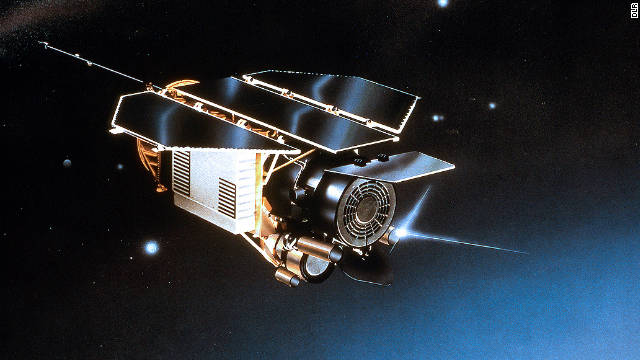updated 10:59 PM EST, Sat October 22, 2011

Artist rendition of the ROSAT German satellite
STORY HIGHLIGHTS
- NEW: Satellite has entered the Earth's atmosphere
- Europe, Asia and Australia were not expected to be in its path
- The biggest fragment will likely be telescope's mirror, weighing up to 1.7 tons
- The location of the debris' surface strikes can't be accurately predicted
Up to 30 pieces of space debris could hit land or water.
Europe, Africa and Australia appeared to be out of the path of the Roentgen Satellite, the agency said late Saturday. It was not immediately clear where the satellite entered the atmosphere.
"The largest single fragment will probably be the telescope's mirror, which is very heat resistant and may weigh up to 1.7 tons," according to the German Aerospace Center.
"The likelihood of a person getting injured as a result of the re-entry is extremely low," the agency said.
Tariq Malik, managing editor of space.com, told CNN Saturday night that "there is no serious contamination threat" from the satellite.
Fragments could fall to Earth in about a 50-mile-wide (80-kilometer-wide) path as the satellite enters the atmosphere at 17,398 mpg (28,000 kph) and breaks up under extreme heat, the agency said earlier.
The satellite's orbit extends to 53 degrees northern and southern latitude, officials said.
The satellite -- an X-ray observatory -- doesn't have a propulsion system, so officials couldn't perform a controlled re-entry at the end of the craft's mission in 1999, the space agency said.
The satellite had been in an elliptical orbit between 351 miles and 363 miles above the surface, but in June, it was only about 203 miles high, the space agency said.
Launched in June 1990, the ROSAT gave scientists for the first time an all-sky survey of X-ray sources with an imaging telescope and discovered that all astronomical objects emit X-ray radiation, including some objects that weren't expected to do so, the space agency said.
The satellite observed the moon, comets, stars, X-ray binary stars, neutron stars, supernovae and supernova remnants, the interstellar medium, galaxies, active galactic nuclei, black holes, nebulae and the cosmic X-ray background, the agency said.
The satellite's mission was supposed to last 18 months. But the ROSAT "proved to be such a great success in terms of the scientific benefits it provided that the mission was extended for as long as was technically feasible," the German agency said.
The mission finally came to an end in 1998 when a star tracker failed and the sun caused irreversible damage. The ROSAT was shut down on February 12, 1999, more than 8 1/2 years after its launch, the space agency said.
The U.S. Department of Defense said that more than 21,800 man-made objects have re-entered Earth's atmosphere since tracking began with Sputnik, the world's first artificial satellite launched by the Soviets in 1957.
Last month, surviving remnants of a NASA satellite re-entered Earth's atmosphere over a remote stretch of the southern Pacific Ocean and broke into pieces during re-entry, with 26 chunks weighing a total of 1,200 pounds considered likely to have reached the surface, NASA said.
Ads by Ves Intelligence
